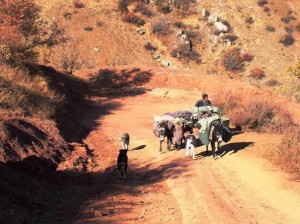
In mid-November, Paul Currion wrote a pointed blog post asking why we see so few interesting thinkers in the aid sector. I tracked him down on skype to talk about it a little more. It turns out we were on slightly different tracks in thinking about this, and it was a useful conversation for me (and I hope Paul). Here’s a recap:
Alanna: The system as a whole doesn’t reward individuals with interesting or innovative ideas. If you think in an unusual way, you’re not perceived as a visionary or a useful contributor. You’re seen as wacky or a complainer. Not a team player. Since we all have to be aware of our next job, we can’t afford to be visionary. And you don’t get to be the kind of senior person who’s allowed to have big ideas by being an interesting thinker. You get to that level by being a good team player.
Paul: The aid bureaucracy is fundamentally a mechanism of control. A civil service mentality. hence the layers upon layers of task forces, working groups, etc. Which doesn’t leave us in a good place, at a time when the sector is really struggling with a massively changed external environment. It’s not just that people don’t care, it’s just that the lack of vision runs so deep that most people don’t even realize it’s a problem.
Alanna: Based on my interactions with people at senior levels in aid, that does tend to be true. I know plenty of front line aid workers who know we have a problem, but they aren’t able to affect things. And the people who can, don’t see a problem.
Paul: The next question is, what do we do?
Alanna: I think the problem at heart comes from the menage a trois, as J put it. The donor’s the customer, and as long as your donor is happy, there is no real drive for change, no matter how much the beneficiary is getting screwed. Which is actually what happens with civil servants, too. And I don’t know how you upset that triangle. For development you can talk about moving away from an aid model, but relief’s pretty much got to be aid.
Paul: It doesn’t seem to me that this is the only problem, or even a substantial problem if other things were fixed. But we can assume that those “other things” won’t get fixed. My argument in the blog post was not so much that the beneficiary is getting screwed but that the sector is just being overtaken by events, and everybody is standing around going “humanitarian reform blah blah blah” without realising that they aren’t wearing any pants.
Alanna: If it’s being overtaken by events, what happens next? Answering my own question: dyncorp, maybe.
Paul: The good news: newly empowered and middle class affected communities. The bad news: military and private contractors. The mixed news: diaspora communities and local political interests. Or maybe nothing happens next, and aid organisations just become increasingly irrelevant because they’re simply failing to meet the challenge.
Alanna: And no one responds to crisis?
Paul: Not in the way that we’re used to seeing. Imagine if there had been a third megadisaster after Haiti and Pakistan. We simply wouldn’t have been able to mount a response. You could see a “hollow” humanitarian sector in the same way as you see hollow states. Activity at the core that makes it look like things are happening, but increasingly little capability outside the core.
************
It was a thought-provoking conversation, and it’s been on my mind ever since. Two things really stick out for me.
The first is the role of local political interests in providing aid after disasters. We’ve seen that many times – Hizbullah providing aid in Lebanon, Islamic groups in Turkey after the Van earthquake last year. There are plenty of non-altruistic reasons to provide aid, and those will not go away if the humanitarian sector as we know it hollows out. It will mean a very different – older – model of aid comes back into practice, though.
The second is the fact that aid bloggers aren’t really addressing the failure to think in an interesting way. We’re not doing the interesting thinking, and we’re not calling people out. I think it’s because most of us are part of the aid establishment, and we all have our next job to think of. We don’t want to be known as wacky troublemakers any more than the next aid worker does. What we really need then is aid journalists. Outsiders, with no vested interested in the system. Tom Paulson can go to the Pacific Health Summit and bug people all he wants. That’s what he’s supposed to do. J from Tales from the Hood can’t do that. J can’t even comfortably tell the truth and use his/her own name.
**********
Some questions to end this post. Is Paul right about the lack of interesting thinkers? Can you recommend some? For me, Ben Ramalingan and Edward Carr come to mind. And some of the most interesting thinkers that are relevant to aid don’t actually write about aid – now I am thinking of Dave Snowden, JP Rangaswami, and Tyler Cowen.
And, finally, an administrative notice. My housing for SXSWi seems to have fallen through. Does anyone need a roommate?
—————
(photo credit: sskennel)








